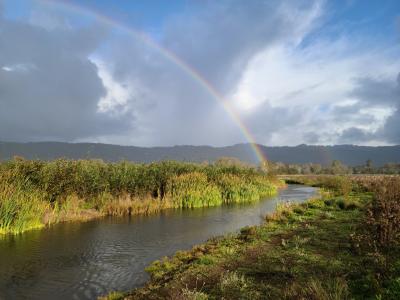Deep Roots — Celebrating 40 Years of Watershed Restoration
April 25 - 28, 2023
The Future Is Now: How To Use Practical Remote Sensing Tools To Gain New Perspectives In River Restoration And Watershed Assessment
26 April 2023
Workshop Coordinators:
Emily Fairfax, California State University, Channel Islands
Eli Asarian, Riverbend Sciences
Adam Cummings, U.S. Forest Service Pacific Southwest Research Station
David Dralle, U.S. Forest Service Pacific Southwest Research Station
Emily Fairfax, California State University, Channel Islands
Eli Asarian, Riverbend Sciences
Adam Cummings, U.S. Forest Service Pacific Southwest Research Station
David Dralle, U.S. Forest Service Pacific Southwest Research Station
Do you want to travel through time, see patterns and colors not visible to the naked eye, and soar thousands of feet in the sky over your field sites? You can - with remote sensing! This full-day workshop provides a hands-on introduction to get you started using remotely sensed datasets and tools for restoration planning and assessment. Thanks to recent technological advances and ever-expanding availability and quality of data, what was once only possible in science fiction is now readily doable from the comfort of your home or office. And this workshop will show you how.
We demystify this avalanche of data by introducing attendees to easy-to-use “no-code” and “low-code” remote sensing tools, ranging from just your web browser to GIS softwares to simple snippets of R and Earth Engine code. In the morning we will walk attendees through: 1) the multitude of types of data available (e.g. vegetation, topography, land cover, land use, and climate) and what they are useful for, and 2) how to efficiently access and analyze these data to better understand landscape conditions and subsequent response to disturbances and/or restoration work. In the afternoon, participants who bring laptops will have a hands-on opportunity to explore data, test-drive tools, and work on projects with instructors available for guidance, discussion, and troubleshooting. If you are brand new to remote sensing , there will be introductory-level mini-projects with step-by-step instructions provided for you to try out. If you are more experienced, we encourage you to come with a location and/or question in mind and work with the instructors to incorporate new remote sensing perspectives.
Examples of practical topics includes in this workshop are: 1) where to find and browse historical and current satellite imagery, aerial photographs, and other remote-sensed data products; 2) how to delineate watersheds upstream of a point; 3) how to generate summarized time series of vegetation, land cover, and climate for areas of interest to assess effects of management, beaver activity, fires, floods, and landscape changes; and 4) tools for analyzing topography. Participants will be given handouts with a list of tools and applications.
To provide attendees with a taste of the potential available through remote sensing techniques more advanced than what we are teaching in this workshop, we will also include a few brief lightning talks featuring examples of remote sensing work conducted by the instructors in support of river restoration.
Workshop Materials
Below are the workshop materials including access to: agenda, 14 tutorials, and spreadsheet listing 28 remote sensing datasets and tools. The workshop materials are hosted on Google Drive and may be updated in the future:
-
Agenda. Two-page agenda including list of 14 tutorials.
-
Tutorials. This electronic handout covers 14 tutorials for remote sensing techniques relevant to restoration projects, grouped into five categories: 1) Imagery and historical maps, 2) Topography visualization to inform restoration design, 3) Watershed delineation, 4) Vegetation, land cover, and watershed disturbance, and 5) Hydrology and climate time series. The tutorials teach methods ranging from basic to advanced, catering to different levels of expertise. Whether new to remote sensing or with prior experience, participants can use this handout to advance their remote sensing abilities and gain new insights to further their salmonid restoration work.
-
Remote Sensing Tools and Datasets. A spreadsheet 28 remote sensing datasets and tools, including some covered in the tutorials. Columns include a summary, URL, description of what makes each tool unique relative to other tools, and links to tutorials and publications.

